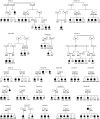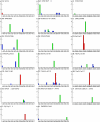Five novel loci for inherited hearing loss mapped by SNP-based homozygosity profiles in Palestinian families
- PMID: 19888295
- PMCID: PMC2987250
- DOI: 10.1038/ejhg.2009.190
Five novel loci for inherited hearing loss mapped by SNP-based homozygosity profiles in Palestinian families
Abstract
In communities with high rates of consanguinity and consequently high prevalence of recessive phenotypes, homozygosity mapping with SNP arrays is an effective approach for gene discovery. In 20 Palestinian kindreds with prelingual nonsyndromic hearing loss, we generated homozygosity profiles reflecting linkage to the phenotype. Family sizes ranged from small nuclear families with two affected children, one unaffected sibling, and parents to multigenerational kindreds with 12 affected relatives. By including unaffected parents and siblings and screening 250 K SNP arrays, even small nuclear families yielded informative profiles. In 14 families, we identified the allele responsible for hearing loss by screening a single candidate gene in the longest homozygous region. Novel alleles included missense, nonsense, and splice site mutations of CDH23, MYO7A, MYO15A, OTOF, PJVK, Pendrin/SLC26A4, TECTA, TMHS, and TMPRSS3, and a large genomic deletion of Otoancorin (OTOA). All point mutations were rare in the Palestinian population (zero carriers in 288 unrelated controls); the carrier frequency of the OTOA genomic deletion was 1%. In six families, we identified five genomic regions likely to harbor novel genes for human hearing loss on chromosomes 1p13.3 (DFNB82), 9p23-p21.2/p13.3-q21.13 (DFNB83), 12q14.3-q21.2 (DFNB84; two families), 14q23.1-q31.1, and 17p12-q11.2 (DFNB85).
Figures



References
-
- Jaber L, Halpern GJ, Shohat T. Trends in the frequencies of consanguineous marriages in the Israeli Arab community. Clin Genet. 2000;58:106–110. - PubMed
-
- Zlotogora J, Barges S, Bisharat B, Shalev SA. Genetic disorders among Palestinian Arabs. 4: Genetic clinics in the community. Am J Med Genet A. 2006;140:1644–1646. - PubMed
-
- Yasunaga S, Grati M, Cohen-Salmon M, et al. A mutation in OTOF, encoding otoferlin, a FER-1-like protein, causes DFNB9, a nonsyndromic form of deafness. Nat Genet. 1999;21:363–369. - PubMed
-
- Mustapha M, Weil D, Chardenoux S, et al. An alpha-tectorin gene defect causes a newly identified autosomal recessive form of sensorineural pre-lingual non-syndromic deafness, DFNB21. Hum Mol Genet. 1999;8:409–412. - PubMed
-
- Zwaenepoel I, Mustapha M, Leibovici M, et al. Otoancorin, an inner ear protein restricted to the interface between the apical surface of sensory epithelia and their overlying acellular gels, is defective in autosomal recessive deafness DFNB22. Proc Natl Acad Sci USA. 2002;99:6240–6245. - PMC - PubMed
Publication types
MeSH terms
Substances
Grants and funding
LinkOut - more resources
Full Text Sources
Molecular Biology Databases

